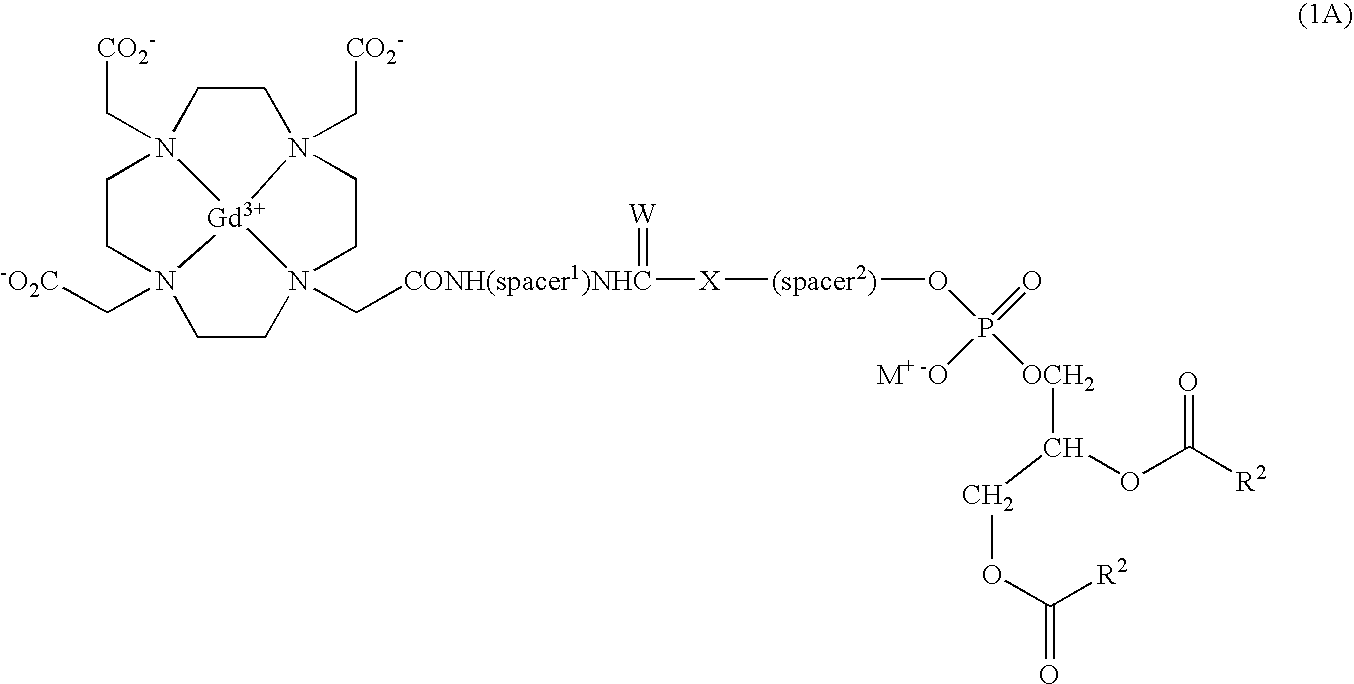Lipophilic derivatives of chelate monoamides
- Summary
- Abstract
- Description
- Claims
- Application Information
AI Technical Summary
Benefits of technology
Problems solved by technology
Method used
Image
Examples
example 1
Synthesis of Amide Gd Ligand
[0125] Scheme 1 illustrates a synthetic scheme for preparing an amide containing ligand for gadolinium. As shown in Scheme 1, reaction of a suitable mono-protected diamine 1 (i.e., 1-(t-butoxycarbonylamino)-6-aminohexane) with a α-halo acetylhalide 2 in the presence of added base (i.e., i-Pr2NEt) gives the α-halo amide 3. Nucleophilic displacement of the α-halo amide with the macrocyclic tetramine 4 (i.e., 1,4,7,10-tetraazacyclododecane) gives the mono-functionalized macrocycle 5 in the presence of added base (i.e., i-Pr2NEt). Further alkylation of the remaining nitrogens in the macrocycle with α-halo-benzyl acetate, 6, in the presence of a suitable base (i.e., i-Pr2NEt) gives the tetrafunctional derivative 7. Removal of the t-butoxycarbonyl group with a suitable acid (i.e., trifluoroacetic acid) gives the amine 8 after neutralization.
[0126] Conversion of the amine 8 to its corresponding isocyanate is achieved by, first formation of the amine carbamate ...
example 2
Introduction of Gadolinium Ion
[0128] Gadolinium ion may be introduced into the chelate either by initially metalating DOTA before or during the preparation of the compound of formula (1) or metalating after synthesis.
[0129] For example, premetalation of DOTA or DOTA′-CONR1 (spacer1) NR1H is carried out in aqueous solution using a stoichiometric amount of GdCl3. The reaction mixture is lyophilized to dryness and used without further purification prior to conjugation with PE or triglycyl-PE. As salts carried onto the final conjugation negatively affect the coupling chemistry, they are removed by aqueous rinses of the dried reaction mixture.
[0130] Gd2O3 may be used in place of GdCl3 to produce a “salt free” metal complex, by boiling the solution containing Gd2O3 for an extended period of time in MeOH / chloroform.
[0131] Postmetalation of the compound of formula (1) is carried out with GdCl3 in a chloroform methanol mixture with boiling or in anhydrous DMF.
example 3
Preparation of Emulsions
[0132] The conjugates of formula (1) are associated with nanoparticles prepared as in Preparation A. Each particle will contain approximately 33,000 Gd3+ chelates.
PUM
 Login to View More
Login to View More Abstract
Description
Claims
Application Information
 Login to View More
Login to View More - R&D
- Intellectual Property
- Life Sciences
- Materials
- Tech Scout
- Unparalleled Data Quality
- Higher Quality Content
- 60% Fewer Hallucinations
Browse by: Latest US Patents, China's latest patents, Technical Efficacy Thesaurus, Application Domain, Technology Topic, Popular Technical Reports.
© 2025 PatSnap. All rights reserved.Legal|Privacy policy|Modern Slavery Act Transparency Statement|Sitemap|About US| Contact US: help@patsnap.com



